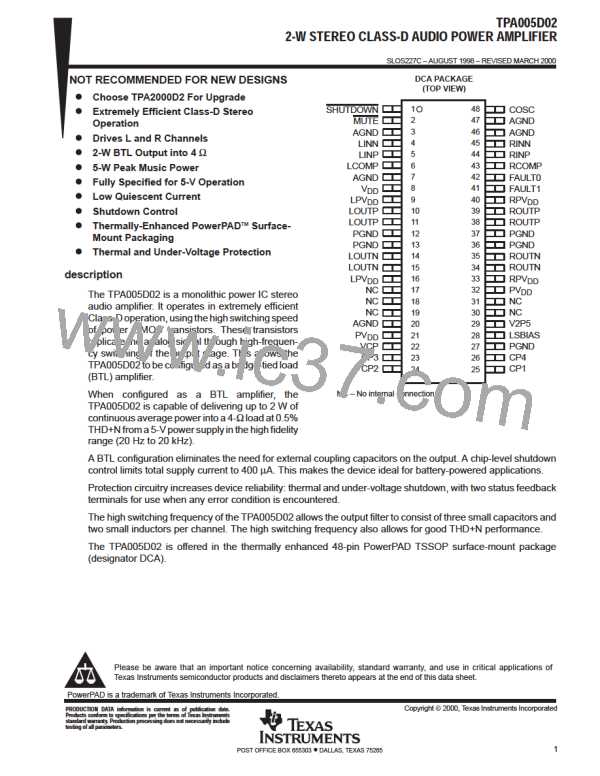TPA005D02
2-W STEREO CLASS-D AUDIO POWER AMPLIFIER
SLOS227C – AUGUST 1998 – REVISED MARCH 2000
APPLICATION INFORMATION
crest factor and thermal considerations
A typical music CD requires 12 dB to 15 dB of dynamic headroom to pass the loudest portions without distortion
as compared with the average power output. From the TPA005D02 data sheet, one can see that when the
TPA005D02 is operating from a 5-V supply into a 4-Ω speaker that 4 W peaks are available. Converting Watts
to dB:
P
W
4
1
P
10Log
10Log
6 dB
(17)
dB
P
ref
Subtracting the crest factor restriction to obtain the average listening level without distortion yields:
( )
12 dB 15 dB crest factor
6.0 dB 18 dB
6.0 dB 15 dB
6.0 dB 12 dB
6.0 dB 9 dB
6.0 dB 6 dB
6.0 dB 3 dB
(
)
)
9 dB 15 dB crest factor
(
6 dB 12 dB crest factor
(
)
)
3 dB 9 dB crest factor
(
0 dB 6 dB crest factor
(
)
3 dB 3 dB crest factor
Converting dB back into watts:
PdB 10
P
10
P
W
ref
(18)
63 mW (18 dB crest factor)
125 mW (15 dB crest factor)
250 mW (12 dB crest factor)
500 mW (9 dB crest factor)
1000 mW (6 dB crest factor)
2000 mW (3 dB crest factor)
This is valuable information to consider when attempting to estimate the heat dissipation requirements for the
amplifier system. Comparing the absolute worst case, which is 2 W of continuous power output with a 3 dB crest
factor, against 12 dB and 15 dB applications drastically affects maximum ambient temperature ratings for the
system. Using the power dissipation curves for a 5-V, 4-Ω system, the internal dissipation in the TPA005D02
and maximum ambient temperatures is shown in Table 4.
21
POST OFFICE BOX 655303 • DALLAS, TEXAS 75265

 TI [ TEXAS INSTRUMENTS ]
TI [ TEXAS INSTRUMENTS ]